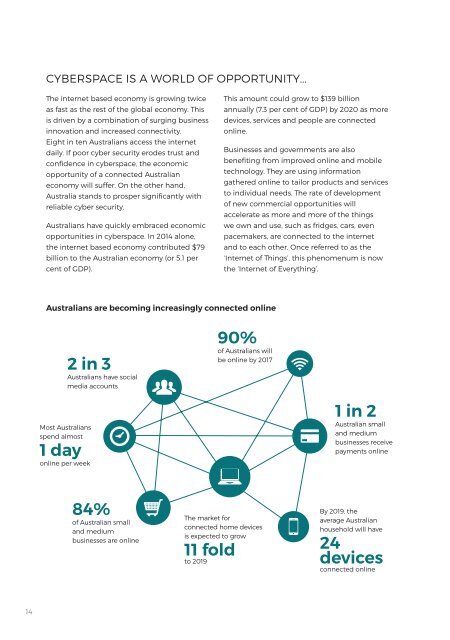AUSTRALIA’S
1Szhz8e
1Szhz8e
Create successful ePaper yourself
Turn your PDF publications into a flip-book with our unique Google optimized e-Paper software.
… BUT CYBER SECURITY THREATS ARE SERIOUS AND<br />
GROWING<br />
As people and systems become increasingly<br />
interconnected, the quantity and value of<br />
information held online has increased. So have<br />
efforts to steal and exploit that information.<br />
Cyberspace, and the dynamic opportunities it<br />
offers, is under persistent threat.<br />
Malicious cyber activity is a security challenge<br />
for all Australians. Australian organisations<br />
across the public and private sectors have<br />
been compromised by state-sponsored or<br />
non-state actors. Overseas, large multinational<br />
companies and government organisations<br />
have been targeted, losing substantial<br />
amounts of sensitive commercial and personal<br />
information or incurring major damage to<br />
their business and reputation.<br />
Figures vary, but cybercrime is estimated<br />
to cost Australians over $1 billion each year.<br />
Worldwide, losses from cyber security attacks<br />
are estimated to cost economies around<br />
one per cent of GDP per year. On this basis,<br />
the real impact of cybercrime to Australia<br />
could be around $17 billion annually. These<br />
costs are expected to rise. Government,<br />
telecommunications, resources, energy,<br />
defence, banking and finance sectors are likely<br />
to remain key targets for cyber criminals and<br />
malicious state actors alike.<br />
The Australian Cyber Security Centre<br />
Threat Report 2015 says the cyber threat is<br />
undeniable, unrelenting and continues to<br />
grow. If an organisation is connected to the<br />
internet, it is vulnerable to compromise—and<br />
the malicious cyber activities in the public eye<br />
are just the tip of the iceberg.<br />
TYPES OF MALICIOUS CYBER ACTIVITY<br />
Malicious cyber activities are wide ranging. They include activities designed to compromise<br />
the confidentiality, integrity or availability of computer networks or ICT systems or<br />
the information on them. The term ‘cyber espionage’ refers to theft of information for<br />
intelligence purposes. ‘Cybercrime’ refers to crimes directed at computers, such as<br />
illegally modifying electronic data or seeking a ransom to unlock a computer affected by<br />
malicious software. It also includes crimes where computers are part of an offence, such as<br />
online fraud.<br />
In this Strategy, the term ‘cyber attack’ refers to deliberate acts that seriously compromise<br />
national security, stability or prosperity by manipulating, denying access to, degrading<br />
or destroying computers or networks or the information resident on them. Other serious<br />
compromises are simply referred to as ‘malicious cyber activity’.<br />
<strong>AUSTRALIA’S</strong> CYBER SECURITY STRATEGY | 15


